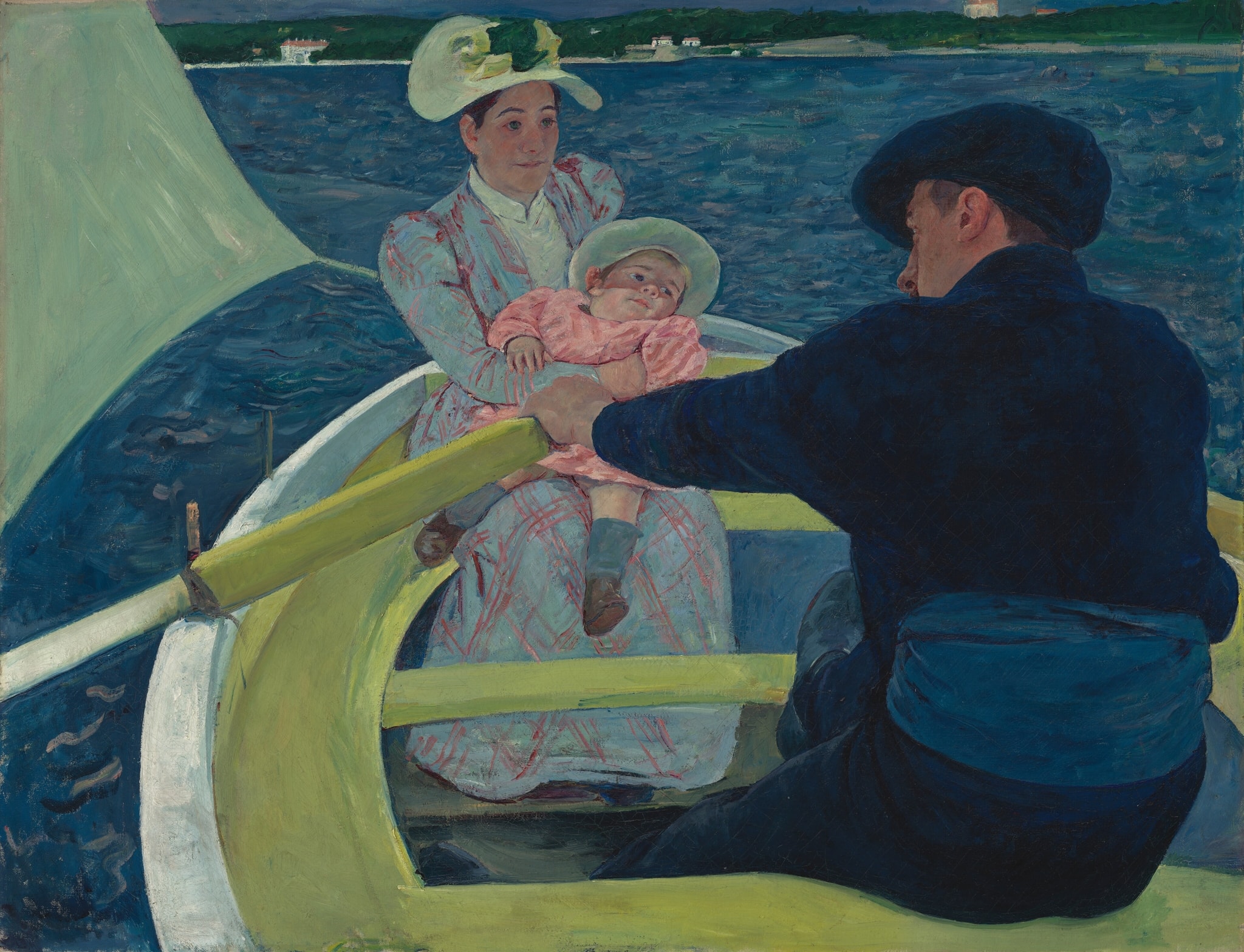The Boating Party
by Mary Cassatt
Fast Facts
- Year
- 1893–1894
- Medium
- Oil on canvas
- Dimensions
- 90 × 117.3 cm
- Location
- National Gallery of Art, Washington, DC

Click on any numbered symbol to learn more about its meaning
Meaning & Symbolism
The meaning of The Boating Party lies in its claim that care is an active, modern force: the mother and child form a protective triangle while the oar’s thrust organizes the world around them. Cassatt stages a negotiation between stability and motion, reading public leisure through a maternal lens and a daring, print‑inspired composition 12. This matters because it reframes modernity not as spectacle but as relational presence, making the boat a provisional home in flux. Understanding why The Boating Party is important clarifies Cassatt’s late‑career synthesis of Impressionist seeing with decorative flatness and feminist attention to gendered space 13.
Cassatt structures the image so that form carries argument. The dark, right‑leaning mass of the rower locks the composition into a planar surface, while the high horizon and cropped sail wedge push depth upward, flattening the sea into broad fields of blue that read almost like cut paper 1. Across this near‑abstract plane, two citron oars and the lemon‑green gunwale carve emphatic diagonals and arcs, counterweighing the rower’s density with a ring that cradles mother and child. This is not incidental design; it is a thesis about orientation. The oar’s long diagonal channels energy toward the infant, whose body tilts back but whose eyes angle forward, meeting our gaze. The mother’s patterned, pale dress stakes a calm interior within the arcs of the boat, a quiet island of care set against the choppy ultramarine. Cassatt’s print‑derived compression—high horizon, oblique vantage, cropped forms—asserts pictorial control over instability, converting the Mediterranean’s glittering flux into a disciplined geometry of protection and passage 12. Within that geometry, Cassatt tests the politics of proximity. The male rower, muscular and absorbed in propulsion, sits apart as a dark silhouette; the mother and child knit together as a luminous unit, their hats and the baby’s socks echoing the boat’s citron chords. The oar doubles as a hinge and a threshold: it enables forward motion yet implies a gendered partition within a shared modern outing, a reading supported by feminist scholarship that charts how Cassatt stages women negotiating public space 3. But the partition is not a barricade. The mother’s left hand supports the child at the very edge of the oar’s sweep, and the boat’s curved rail repeats the arc of her arm, visually confirming that maternal care is the boat’s true stabilizer. The composition’s strongest vectors—oar, gunwale, sail edge—converge to protect and present the child, retooling traditions of the Madonna and Child into a secular, contemporary rite of guidance. Cassatt’s triangulation of heads (mother–child–rower) implies continuity across roles: labor, care, and learning align toward a shared horizon, the distant white villas reduced to accents that register destination without distracting from the human bond 24. Color completes the argument. Cassatt’s Antibes palette adopts intense southern light, pushing her beyond broken Impressionist strokes toward decorative clarity: citron against ultramarine, pale rose against navy, each organized into broad, legible fields 14. The rower’s nearly monochrome navy mass anchors the right side like ballast; the mother’s pink‑and‑white dress diffuses into patterned calm; the baby’s soft salmon and mint hues pick up the boat’s chords, visually suturing care to structure. Rather than narrate a charming excursion, Cassatt declares that modern life’s precariousness—signaled by water that nearly meets the boat’s rim—can be met with composed attention. The immediacy of the viewpoint places us inside the skiff, responsible for maintaining the balance the figures already perform. That is why The Boating Party is important: it crystallizes Cassatt’s late‑19th‑century synthesis of Impressionist perception and Japonisme design into a persuasive ethics of seeing, where composition is care and motion becomes a medium for relation 123.Citations
- National Gallery of Art, The Boating Party (object record and curatorial text)
- The Met Heilbrunn Timeline, H. Barbara Weinberg, “Mary Stevenson Cassatt (1844–1926)”
- Griselda Pollock, Mary Cassatt: Painter of Modern Women (Thames & Hudson)
- National Gallery of Art, Mary Cassatt: Modern Woman (exhibition overview)
- Smithsonian National Postal Museum, 5-cent “Mary Cassatt – The Boating Party” stamp (1966)
- Mary Cassatt: Modern Woman (Exhibition and Catalogue, AIC/MFA/NGA, 1998–99)
Explore Deeper with AI
Ask questions about The Boating Party
Popular questions:
Powered by AI • Get instant insights about this artwork
Interpretations
Historical Context
Source: National Gallery of Art; The Met Heilbrunn; Mary Cassatt: Modern Woman (AIC/NGA/MFA)
Formal Analysis
Source: National Gallery of Art; Mary Cassatt: Modern Woman (AIC/NGA/MFA)
Social Commentary
Source: Griselda Pollock, Mary Cassatt: Painter of Modern Women; National Gallery of Art
Biographical
Source: The Met Heilbrunn; Mary Cassatt: Modern Woman (AIC/NGA/MFA); National Gallery of Art
Reception History
Source: Smithsonian National Postal Museum; National Gallery of Art; Mary Cassatt: Modern Woman (AIC/NGA/MFA)
Symbolic Reading
Source: The Met Heilbrunn; Mary Cassatt: Modern Woman (AIC/NGA/MFA); National Gallery of Art
